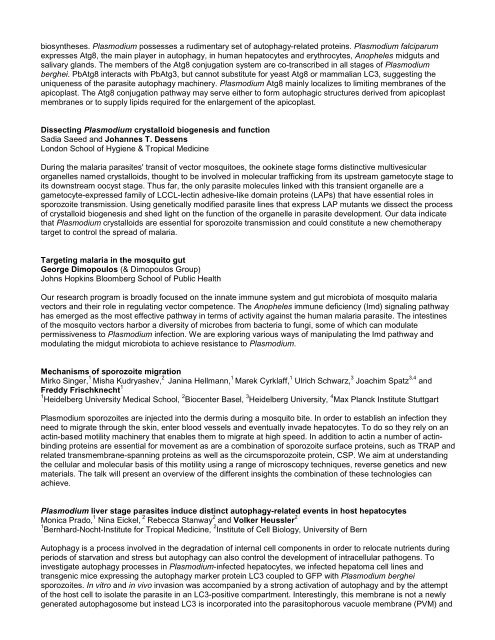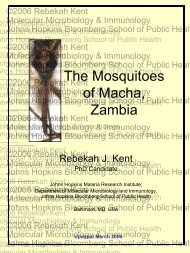Conference Program - Johns Hopkins Malaria Research Institute ...
Conference Program - Johns Hopkins Malaria Research Institute ...
Conference Program - Johns Hopkins Malaria Research Institute ...
Create successful ePaper yourself
Turn your PDF publications into a flip-book with our unique Google optimized e-Paper software.
iosyntheses. Plasmodium possesses a rudimentary set of autophagy-related proteins. Plasmodium falciparum<br />
expresses Atg8, the main player in autophagy, in human hepatocytes and erythrocytes, Anopheles midguts and<br />
salivary glands. The members of the Atg8 conjugation system are co-transcribed in all stages of Plasmodium<br />
berghei. PbAtg8 interacts with PbAtg3, but cannot substitute for yeast Atg8 or mammalian LC3, suggesting the<br />
uniqueness of the parasite autophagy machinery. Plasmodium Atg8 mainly localizes to limiting membranes of the<br />
apicoplast. The Atg8 conjugation pathway may serve either to form autophagic structures derived from apicoplast<br />
membranes or to supply lipids required for the enlargement of the apicoplast.<br />
Dissecting Plasmodium crystalloid biogenesis and function<br />
Sadia Saeed and Johannes T. Dessens<br />
London School of Hygiene & Tropical Medicine<br />
During the malaria parasites' transit of vector mosquitoes, the ookinete stage forms distinctive multivesicular<br />
organelles named crystalloids, thought to be involved in molecular trafficking from its upstream gametocyte stage to<br />
its downstream oocyst stage. Thus far, the only parasite molecules linked with this transient organelle are a<br />
gametocyte-expressed family of LCCL-lectin adhesive-like domain proteins (LAPs) that have essential roles in<br />
sporozoite transmission. Using genetically modified parasite lines that express LAP mutants we dissect the process<br />
of crystalloid biogenesis and shed light on the function of the organelle in parasite development. Our data indicate<br />
that Plasmodium crystalloids are essential for sporozoite transmission and could constitute a new chemotherapy<br />
target to control the spread of malaria.<br />
Targeting malaria in the mosquito gut<br />
George Dimopoulos (& Dimopoulos Group)<br />
<strong>Johns</strong> <strong>Hopkins</strong> Bloomberg School of Public Health<br />
Our research program is broadly focused on the innate immune system and gut microbiota of mosquito malaria<br />
vectors and their role in regulating vector competence. The Anopheles immune deficiency (Imd) signaling pathway<br />
has emerged as the most effective pathway in terms of activity against the human malaria parasite. The intestines<br />
of the mosquito vectors harbor a diversity of microbes from bacteria to fungi, some of which can modulate<br />
permissiveness to Plasmodium infection. We are exploring various ways of manipulating the Imd pathway and<br />
modulating the midgut microbiota to achieve resistance to Plasmodium.<br />
Mechanisms of sporozoite migration<br />
Mirko Singer, 1 Misha Kudryashev, 2 Janina Hellmann, 1 Marek Cyrklaff, 1 Ulrich Schwarz, 3 Joachim Spatz 3,4 and<br />
Freddy Frischknecht 1<br />
1 Heidelberg University Medical School, 2 Biocenter Basel, 3 Heidelberg University, 4 Max Planck <strong>Institute</strong> Stuttgart<br />
Plasmodium sporozoites are injected into the dermis during a mosquito bite. In order to establish an infection they<br />
need to migrate through the skin, enter blood vessels and eventually invade hepatocytes. To do so they rely on an<br />
actin-based motility machinery that enables them to migrate at high speed. In addition to actin a number of actinbinding<br />
proteins are essential for movement as are a combination of sporozoite surface proteins, such as TRAP and<br />
related transmembrane-spanning proteins as well as the circumsporozoite protein, CSP. We aim at understanding<br />
the cellular and molecular basis of this motility using a range of microscopy techniques, reverse genetics and new<br />
materials. The talk will present an overview of the different insights the combination of these technologies can<br />
achieve.<br />
Plasmodium liver stage parasites induce distinct autophagy-related events in host hepatocytes<br />
Monica Prado, 1 Nina Eickel, 2 Rebecca Stanway 2 and Volker Heussler 2<br />
1 Bernhard-Nocht-<strong>Institute</strong> for Tropical Medicine, 2 <strong>Institute</strong> of Cell Biology, University of Bern<br />
Autophagy is a process involved in the degradation of internal cell components in order to relocate nutrients during<br />
periods of starvation and stress but autophagy can also control the development of intracellular pathogens. To<br />
investigate autophagy processes in Plasmodium-infected hepatocytes, we infected hepatoma cell lines and<br />
transgenic mice expressing the autophagy marker protein LC3 coupled to GFP with Plasmodium berghei<br />
sporozoites. In vitro and in vivo invasion was accompanied by a strong activation of autophagy and by the attempt<br />
of the host cell to isolate the parasite in an LC3-positive compartment. Interestingly, this membrane is not a newly<br />
generated autophagosome but instead LC3 is incorporated into the parasitophorous vacuole membrane (PVM) and



